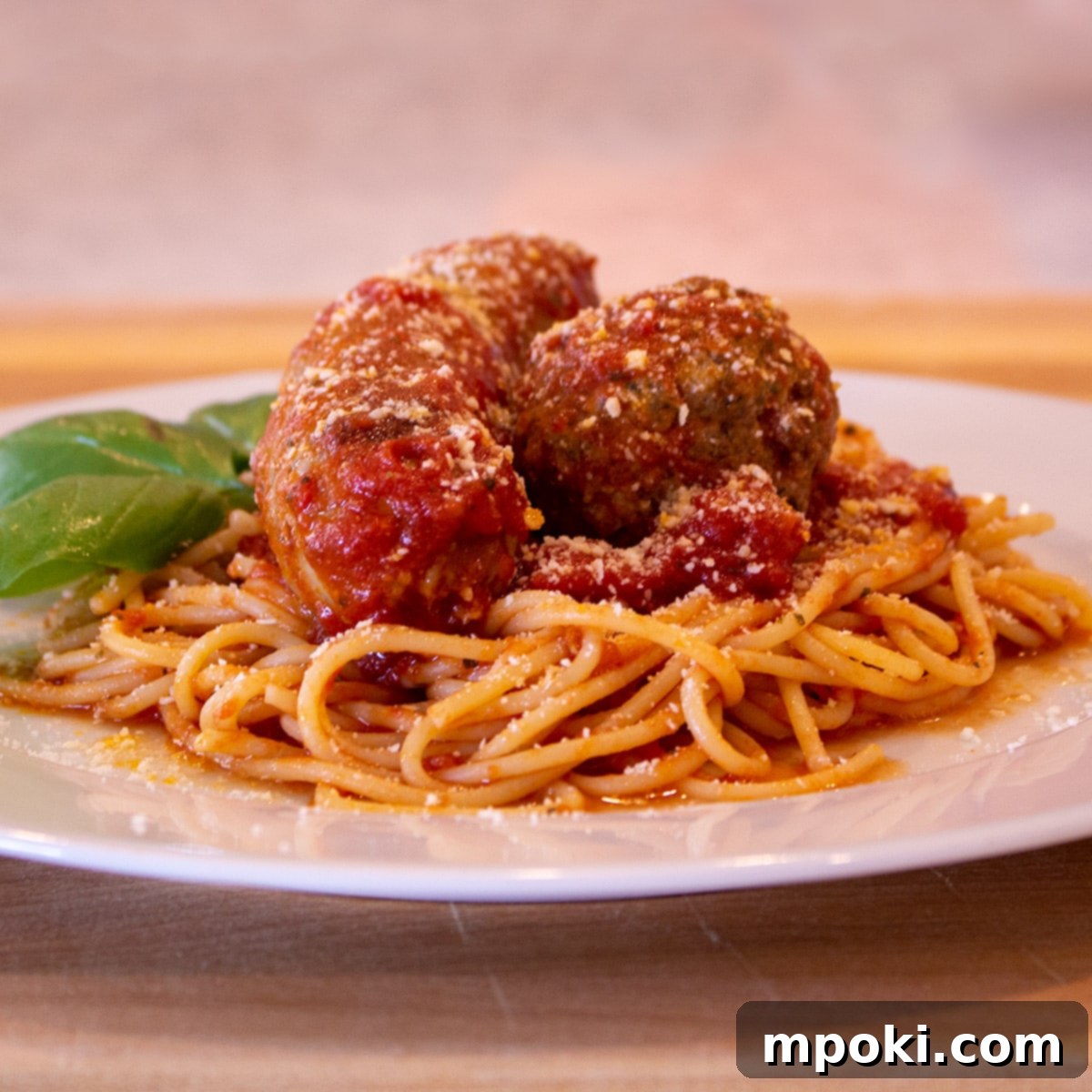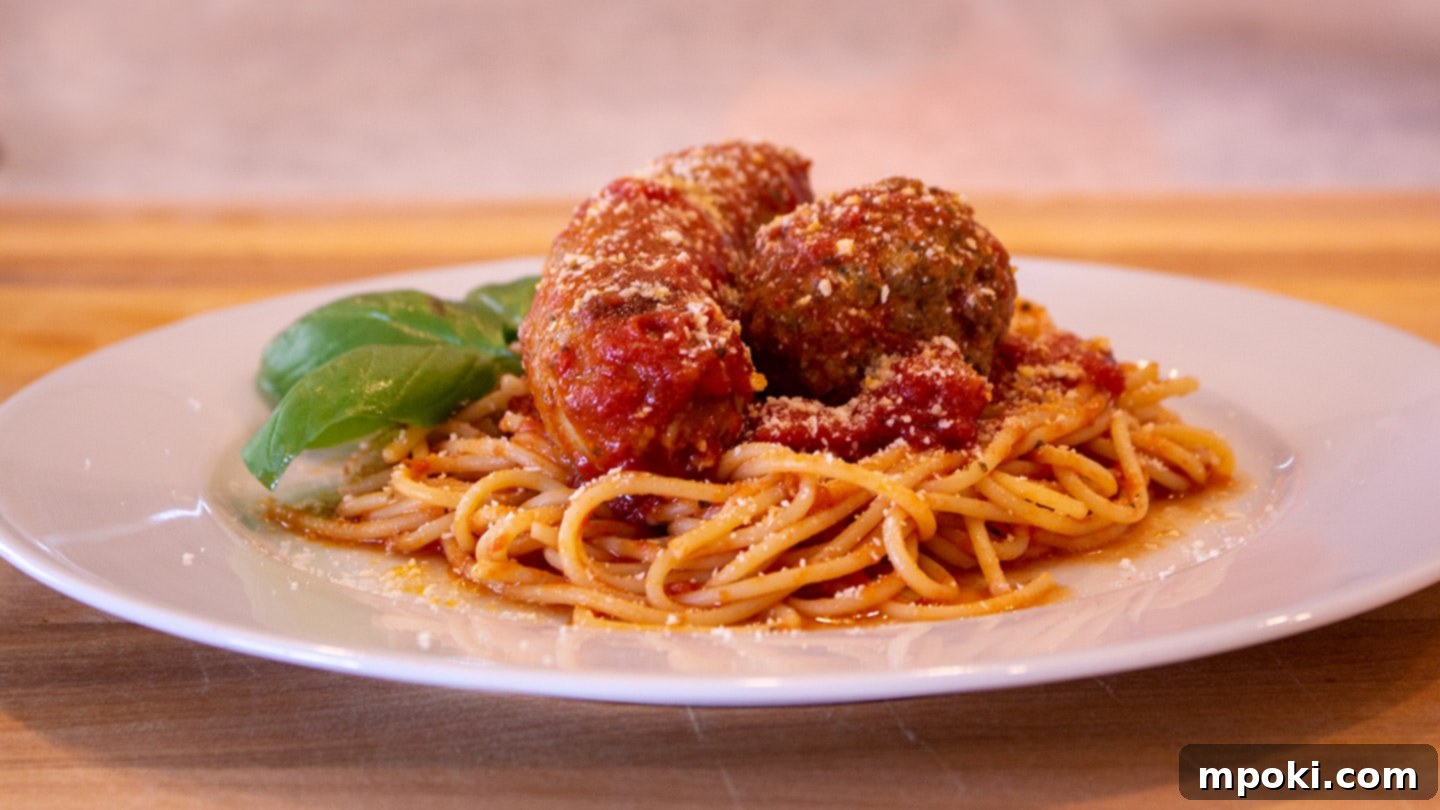
The Ultimate Guide to Traditional Italian Sunday Sauce: A Family Legacy Worth Savoring
There are dishes that simply nourish the body, and then there are dishes that feed the soul. Italian Sunday Sauce, or “Gravy” as it’s affectionately known in many Italian-American households, falls squarely into the latter category. This isn’t just a meal; it’s a centuries-old tradition, a culinary ritual that transforms simple ingredients into a rich, complex, and deeply satisfying experience. Prepare for an all-day affair in the kitchen, a labor of love that is undoubtedly worth every minute of your time.
This Page Contains Affiliate Links. For more Info See My Disclosures here.
A Taste of Childhood: Rediscovering Sunday Gravy
For many, the aroma of Sunday Sauce simmering on the stovetop evokes powerful childhood memories. It was a scent that promised warmth, family gatherings, and an unforgettable meal. Whether you call it “sauce” or “gravy” often depends on your family’s regional Italian roots or even just personal preference – but the heart of the dish remains the same: a slow-cooked, deeply flavorful tomato base brimming with tender meats. My Nana’s (or Mom’s, depending on who you ask!) recipe, passed down through generations, truly embodies this tradition. While there are quicker alternatives, like the Instant Pot version I’ve shared before, sometimes you simply need to embrace the old-school method to achieve that unparalleled depth of flavor and comforting nostalgia.
The Secret to Exceptional Flavor: Quality Ingredients
Given the simplicity of ingredients in this traditional recipe, the quality of each component is absolutely paramount. There are no shortcuts here if you want to create a truly authentic and delicious Sunday Sauce. Every choice you make, from the tomatoes to the meats, contributes significantly to the final masterpiece.
The Foundation: San Marzano Tomatoes
When it comes to tomatoes, I stand firm: it’s San Marzano or bust. These plum tomatoes, grown in the Agro Sarnese-Nocerino region of Italy, are renowned for their balanced sweetness, low acidity, and thick flesh. Their superior flavor profile makes an undeniable difference in the sauce, providing a robust and authentic base that other canned tomatoes simply cannot replicate. Look for cans explicitly labeled “DOP” (Denominazione d’Origine Protetta) for genuine San Marzano tomatoes, ensuring you’re getting the best quality available.
Homemade Meats: The Heart of the Sauce
Beyond the tomatoes, the meats are where this sauce truly shines. Using store-bought, frozen meatballs is a cardinal sin in Italian cooking. Making your own Italian meatballs from scratch is surprisingly easy and delivers an extraordinary boost in flavor and texture. They absorb the sauce beautifully and remain tender throughout the long simmer. I promise, once you try homemade meatballs in your Sunday Sauce, you’ll never go back. Similarly, quality Italian sausage adds another layer of savory richness. Opt for good quality pork sausage, either sweet or hot, depending on your preference, or even a mix of both for a balanced flavor.
Step 1: Preparing Your San Marzano Tomatoes
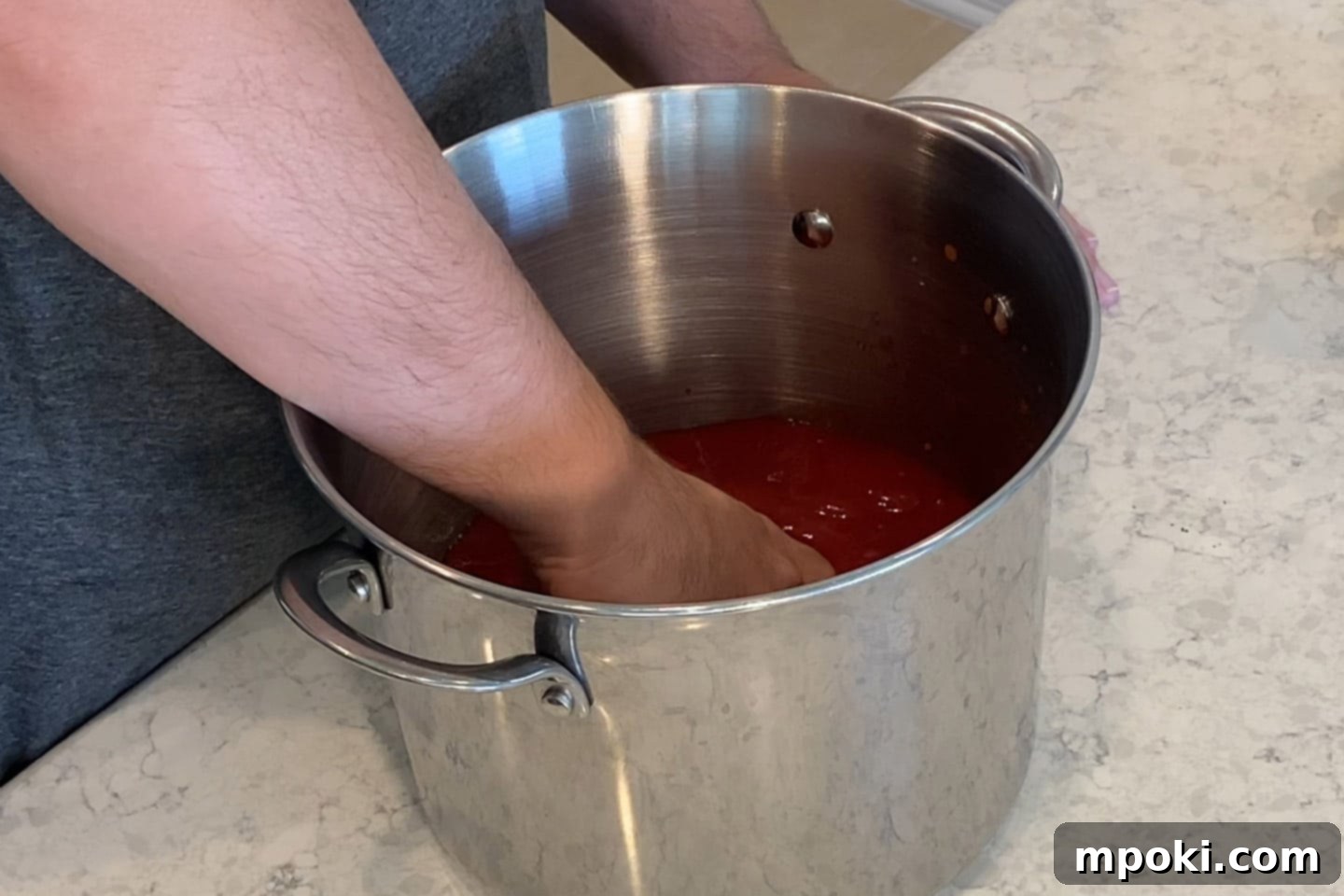
Begin by carefully emptying two 28-ounce cans of peeled plum San Marzano tomatoes into a large, heavy-bottomed pot. The “heavy-bottomed” aspect is crucial here, as it will help distribute heat evenly and prevent scorching during the long simmering process. Now comes the fun part: roll up your sleeves and get your hands dirty! Submerge your hands into the pot and gently, yet firmly, crush the tomatoes. The goal is to break them down into a rustic, chunky consistency, rather than a smooth puree. Be sure to keep your hands fully submerged to avoid a messy splatter. This hands-on method allows you to feel the texture and ensures a more authentic, homemade feel than using a food processor. Once crushed, place the pot on your stovetop over the lowest possible heat setting. This will allow the tomatoes to begin their slow transformation while you prepare the meats.
Step 2: Browning the Meats for Maximum Flavor

The next critical step involves browning your Italian sausage and homemade meatballs. This isn’t just about cooking them; it’s about developing deep, caramelized flavors through the Maillard reaction. This golden-brown crust will infuse the entire sauce with incredible richness.
In a large, high-sided sauté pan or a spacious frying pan, add a generous drizzle of olive oil over medium heat. Start with the Italian sausage. Fry each link for a couple of minutes per side, turning them until they achieve a beautiful golden-brown color. Don’t worry about cooking them through at this stage; we’re simply building a flavorful exterior. Once browned, transfer the sausage directly into the pot with your crushed San Marzano tomatoes.

Now, add a little more olive oil to the same pan if needed, and it’s time for the meatballs. Place them in the hot pan, ensuring not to overcrowd it (cook in batches if necessary). Fry them for a few minutes on each side until they are nicely browned all around. Like the sausage, the goal is a delicious sear, not to cook them entirely through. Once browned, remove the meatballs from the pan and place them in the refrigerator. We’ll add them back into the sauce a few hours later, preventing them from disintegrating during the long simmer and ensuring they retain their perfect shape and texture.
Step 3: Building Flavor with Tomato Paste and Deglazing
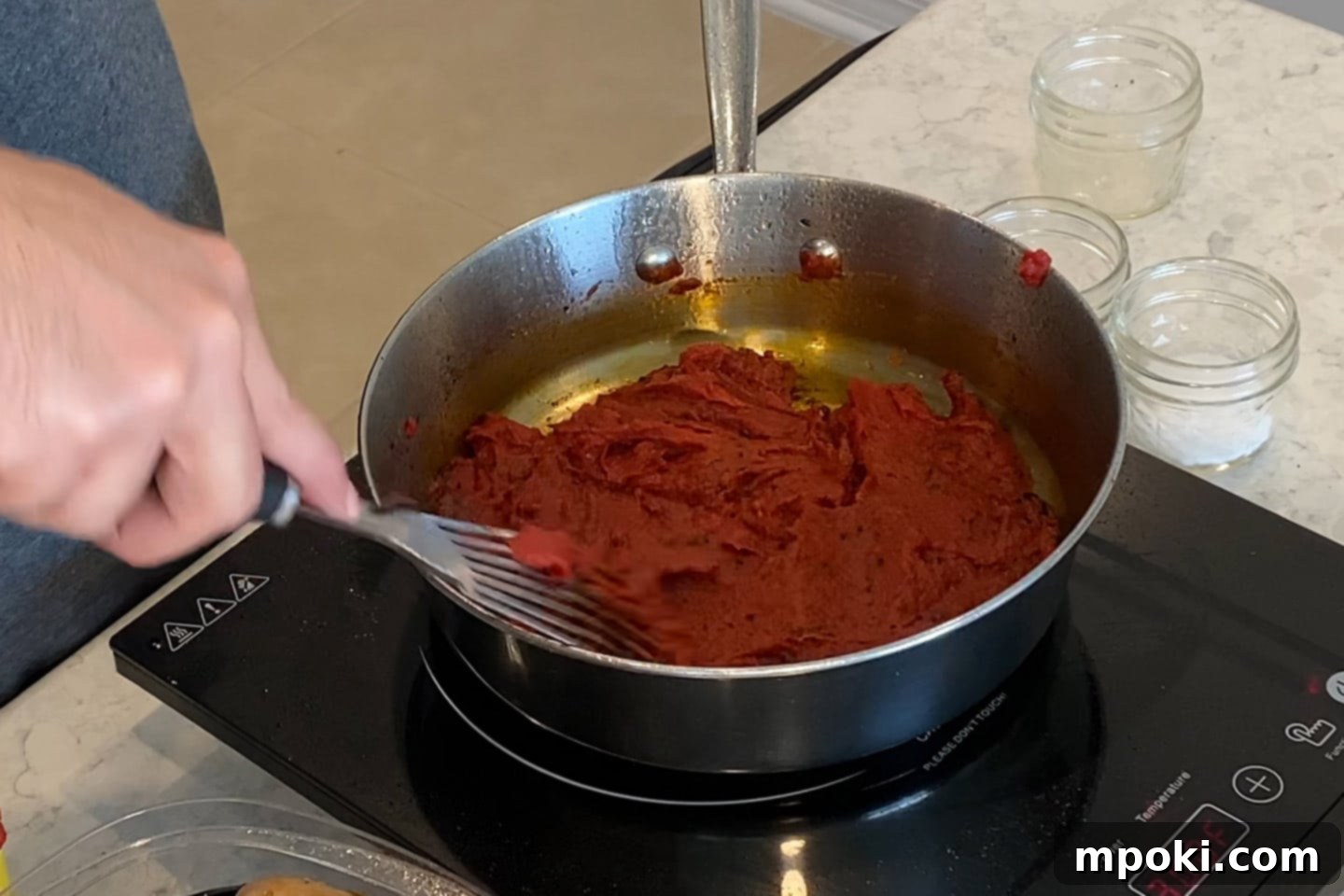
This stage is where we truly intensify the flavor of our Sunday Sauce. After removing the meats, you’ll notice delicious browned bits (fond) stuck to the bottom of your frying pan. These are pure flavor, and we’re going to use them to our advantage. Add two tablespoons of minced garlic to the pan. This is my first little “tweak” to Nana’s original recipe, which often relied solely on dried spices. But who can resist the aromatic allure of fresh garlic?
Stir the minced garlic, scraping the bottom of the pan with a metal or sturdy plastic spatula to release all those beautiful caramelized bits. Allow the garlic to become fragrant, but be careful not to burn it. Next, add two 6-ounce cans of tomato paste to the pan. Work the paste into the garlic and pan drippings, flattening it out slightly. Let it cook for several minutes, stirring occasionally. My mom’s instruction for this step was always to “let it almost burn.” What this means is to caramelize the tomato paste, deepening its color to a rich brick red and developing a profound, concentrated flavor that will be the backbone of your sauce.
Once the tomato paste has achieved that wonderful, almost-burnt color, fill one of the empty tomato paste cans with water and add it to the pan. This is the deglazing process. The water will help lift all the flavorful fond from the bottom of the pan. Scrape and stir vigorously, ensuring every last bit of goodness is incorporated into this rich, tomato-garlic mixture. Finally, pour this entire flavorful concoction into the heavy-bottomed pot with your crushed tomatoes and browned sausage.
Step 4: Seasoning and Beginning the Simmer
With all the primary ingredients now combined, it’s time to season the sauce to perfection. Add one teaspoon of onion powder and one tablespoon of garlic powder. For salt and pepper, start with one tablespoon of sea salt and a few generous turns of a pepper grinder. Remember, you’ll have opportunities to adjust seasoning later, so don’t overdo it initially.
This is where I introduce my second personal touch to Nana’s recipe: dried basil. While some traditionalists might stick to simply salt and pepper, I find that one tablespoon of dried basil (or fresh, if you have it on hand and finely chopped) adds a wonderful aromatic depth that beautifully complements the rich tomato and meat flavors. Stir everything thoroughly to ensure the spices are well distributed throughout the sauce. The kitchen should now be filled with an incredibly inviting aroma.
Step 5: The Long, Slow Simmer – Patience is Key
Now, the real magic begins. Cover the pot, ensuring it’s sealed well, and continue to simmer the sauce on the absolute lowest heat setting for three hours. This slow-cooking process is what allows all the flavors to meld and deepen, transforming individual ingredients into a harmonious, complex sauce.
However, “set it and forget it” is NOT the approach here. You must stir the sauce every 15-30 minutes without fail. This frequent stirring is paramount, especially with a heavy-bottomed pot, to prevent the bottom from scorching. If the sauce burns at the bottom, that acrid taste will permeate the entire pot, rendering your hard work bitter and inedible. It’s a tedious but absolutely essential step for a truly perfect Sunday Sauce. Resist the urge to turn up the heat; low and slow is the secret to tender meats and a rich, developed sauce.
Step 6: Reintroducing the Meatballs and Final Simmer
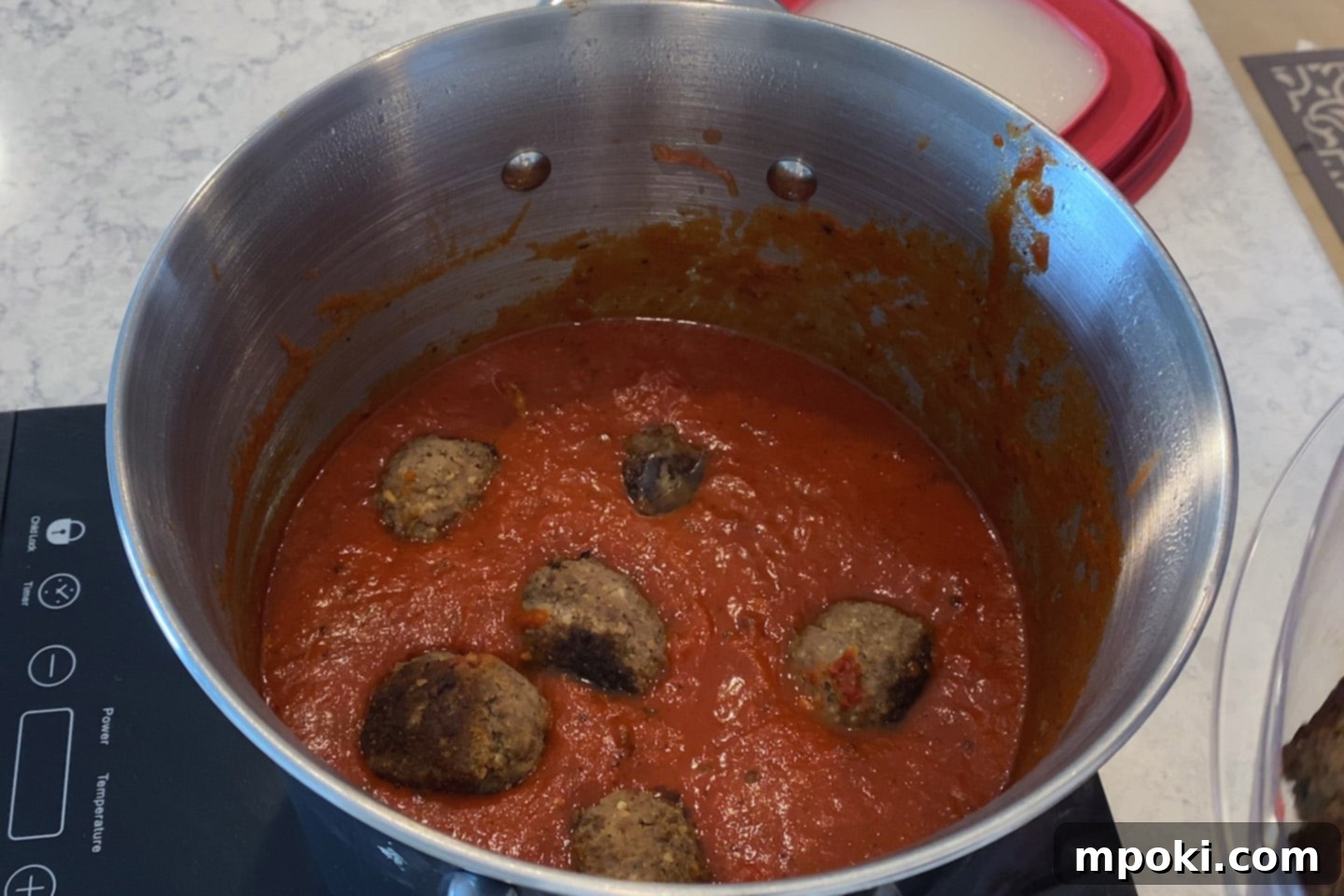
After three hours of diligent simmering, it’s time to welcome the meatballs back into the pot. Remember those browned meatballs we refrigerated? This is why we waited. If you had added them at the beginning with the sausage, they would likely have disintegrated by now, turning into a general meaty mash rather than distinct, tender meatballs. Gently place the meatballs into the simmering sauce.
At this point, you have another crucial opportunity to taste the sauce and adjust the seasonings. Taste it carefully. Does it need more salt? A pinch more pepper? Perhaps a touch more garlic powder, onion powder, or that aromatic basil? Adjust to your personal preference, remembering that the flavors will continue to deepen. Once seasoned, continue to simmer the sauce for an additional two hours, this time uncovered. This allows some of the moisture to evaporate, further concentrating the flavors and thickening the sauce to that perfect consistency. Again, continue to stir every 15-30 minutes to prevent any sticking or burning.
The Moment of Truth: Time to Eat!
After five glorious hours of simmering, stirring, and anticipation, your traditional Italian Sunday Sauce is finally ready! This long adventure in the kitchen culminates in a sauce that is rich, aromatic, and bursting with layers of flavor. Perform one final taste test and make any last-minute seasoning adjustments. My personal tip is always to ensure you’ve added enough salt. A sauce lacking sufficient salt will often taste flat or “off.” I usually start with the initial tablespoon and then find myself adding another teaspoon or two throughout the cooking process. Trust your palate!
Serve this magnificent sauce generously over your favorite pasta. Classic choices include spaghetti, rigatoni, or ziti, which all do an excellent job of cradling the rich sauce and tender meats. Don’t forget a sprinkle of freshly grated Parmigiano-Reggiano or Pecorino Romano cheese and some crusty Italian bread for dipping.
The Magic of Leftovers: A Sauce That Only Gets Better
One of the most wonderful aspects of traditional Sunday Sauce is that it’s one of those rare dishes where the leftovers are arguably even better than the fresh batch. The flavors continue to meld and develop overnight, creating an even richer and more profound taste experience the next day. I absolutely love using the leftover sauce to make hearty sausage and meatball sandwiches on a crusty roll, or incorporating it into a comforting baked pasta dish like lasagna or baked ziti. This sauce isn’t just a meal; it’s a culinary memory, bringing me right back to my childhood kitchen. Enjoy the legacy!

Traditional Italian Sunday Sauce Recipe
Print
Pin
Rate
Equipment
- Heavy Bottomed Pot
- Larger Frying Pan
- Can Opener
- Spatula – Metal or Hard Plastic
Ingredients
- 2 28 oz cans of San Marzano peeled plum tomatoes
- 2 6 oz cans of tomato paste
- 5 Italian sausages (sweet or hot)
- 9-12 Homemade Italian Meatballs Recipe in Notes
- 1 teaspoon Onion powder
- 1 tablespoon Garlic powder
- 2 tablespoon Minced fresh garlic
- 1 tablespoon Dried Basil (or fresh, chopped)
- Sea salt To taste (Start with 1 tbsp, adjust as needed)
- Freshly ground black pepper To taste (as spicy as you like)
- Olive oil
Instructions
- Empty two 28-ounce cans of peeled plum San Marzano tomatoes into a large, heavy-bottomed pot. Using your clean hands, crush the tomatoes while keeping your hands submerged in the liquid to prevent splattering. Place the pot on a burner over low heat.
- In a large frying pan, add some olive oil over medium heat. Fry the Italian sausages for a couple of minutes per side until nicely browned. Transfer the browned sausages to the pot with the crushed tomatoes.
- Add a bit more olive oil to the same frying pan if necessary. Fry the homemade meatballs for a couple of minutes per side until they are nicely browned. Remove the browned meatballs from the pan and place them in the refrigerator for later use.
- Add 2 tablespoons of minced fresh garlic to the frying pan. Stir and scrape the bottom of the pan to deglaze and release all the flavorful browned bits from frying the meats. Cook until fragrant, about 1 minute.
- Add two 6-ounce cans of tomato paste to the pan. Scrape and stir to mix everything into the paste, flattening it out slightly. Let it cook for several minutes, stirring occasionally, until the paste has deepened in color to an almost-burnt brick red. Fill one of the empty tomato paste cans with water and add it to the pan, scraping and mixing well to incorporate all the pan drippings. Pour this entire flavorful mixture into the pot with the tomatoes and sausage.
- Add 1 teaspoon of onion powder, 1 tablespoon of garlic powder, 1 tablespoon of dried basil, and salt and pepper to taste. Begin with 1 tablespoon of sea salt and adjust pepper to your liking. Stir thoroughly to combine all seasonings.
- Cover the pot and simmer on low heat for 3 hours. Crucially, stir the sauce every 15-30 minutes to prevent the bottom from burning. A heavy-bottomed pot is essential here to help distribute heat evenly. If the sauce burns at the bottom, the bitter taste will affect the entire pot.
- After the initial 3 hours, add the refrigerated meatballs to the pot. Taste the sauce again and adjust any seasonings as needed (more salt, pepper, garlic powder, onion powder, or basil). Continue to simmer for an additional 2 hours, this time uncovered. Remember to stir every 15-30 minutes.
- Once the full 5 hours of cooking are complete, taste the sauce for a final seasoning adjustment. Ensure there is enough salt; an undersalted sauce will taste flat. Serve your rich, traditional Italian Sunday Sauce over your pasta of choice, garnished with fresh cheese.
Video
Notes
https://dadgotthis.com/italian-meatballs-recipe/
Nutrition
 Tried this recipe?Mention @DadGotThis or tag #DadGotThis!
Tried this recipe?Mention @DadGotThis or tag #DadGotThis!Connect with Dad on YouTube for More Culinary Adventures!
If you enjoyed this deep dive into traditional Italian cooking, you’ll love my YouTube channel! I share a variety of cooking videos, food-related content, and family recipes, all presented with my signature “Dad” style. It’s a great place to pick up new tips, discover delicious meals, and join a community of food enthusiasts.
Subscribe to the Dad Got This YouTube Channel Here!
Essential Companion: Dad’s Italian Meatball Recipe
As mentioned, homemade meatballs are a non-negotiable for an authentic Sunday Sauce. They bring incredible texture and absorb the rich flavors of the sauce like nothing else. To truly elevate your Sunday Sauce, you absolutely must make them from scratch. I’ve got a super easy recipe that guarantees tender, flavorful meatballs every time.
Get the full recipe for Dad’s Easy Italian Meatballs here and complete your ultimate Italian Sunday Feast!
